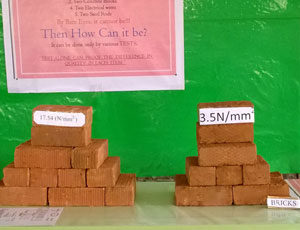Bricks
Overview:
 Bricks are undoubtedly amongst the most commonly used construction materials anywhere. Bricks of different varieties are available in the market such as clay bricks, cement bricks, fly ash bricks and so on. However, the most commonly used and readily available type is the clay brick. The details and quality tests to be discussed in this submit are on clay bricks.
Bricks are undoubtedly amongst the most commonly used construction materials anywhere. Bricks of different varieties are available in the market such as clay bricks, cement bricks, fly ash bricks and so on. However, the most commonly used and readily available type is the clay brick. The details and quality tests to be discussed in this submit are on clay bricks.
In the case of apartment, the entire load is taken cases. If of the framed structure and hence the general feeling of everyone is, it is only for the purpose of partition. Hence, in general all inside walls are made up of 4 inch brick walls and all outside walls and wall in between two apartments are made up of 9 Inch Wall.
Nowadays, everyone preferred to conceal wiring and concealed Pipe Lines. So 2 to 2½ inches are cut open on these 4 inch walls and many places, similarly most of the junction boxes & switch boxes require more space & hence wall is broken through
When the routine cutting is done, if one practically goes near the wall, we can see the wall just float/shaken as if it may fall at any time. Then usually the pipes are fixed, concrete / market covered and plastered and strengthens their 4 inch wall.4 inch walls cover the most of the walls generally in apartments.
If a stronger brick over used in these 4 inch walls (and so has to be in 9 inch walls also) this shake and little cracks can be avoided, though the cost of the stronger bricks is almost double.The Cost of a normal brick is Rs.5 /- it receipts the load of 4N/mm2.Rather cost of wire cut brick is Rs.11 /-but it receipts the load up to 18 N/mm2.We get 41/2 times stronger bricks when we double the cost.
Testing Method
Water absorption test: Five bricks are picked at random from a stack of bricks intended to be used. They are then dried thoroughly in a laboratory oven at a temperature between 105¤C to 110¤C. Thereafter they are cooled and weighed separately. Then they are kept immersed in cold water (27¤C or – 2¤C). After 24 hours the bricks are taken out of water and excess surface water is wiped off using a damp fabric. Immediately after, they are weighed again separately. Supposing that the dry weight of a brick is Wd and the wet weight of the same brick is Ww, the water absorption capacity of the brick expressed in percentage of its dry wt. is = (Ww – Wd)/Wd X 100. Upon calculating the same for each of the 5 bricks the average is finding out which is considered as the water absorption capacity for the bricks. The water absorption capacity of first class bricks should not exceed 20% when calculated as described above. The same for 2nd and 3rd class bricks are not to exceed 22% and 25% respectively. For any superior quality brickwork, first class bricks only are recommended while 2nd & 3rd class clay bricks are advised for moderate to low quality work.
Normal Quality
Brick- 4N/mm2 –Cost Rs.5 /-


